|
|
Oleander

|
|
 |
|
|
Oleander was the first German Thoroughbred to prove his racing mettle on the European stage, performing admirably in two runnings of the Prix de l'Arc de Triomphe, in the days when that race was steadily becoming the premier European event for horses three-years-old and up. As a stallion, Oleander is regarded as probably the most influential German sire, fathering a healthy number of classic winners in his native land, and several offspring who were more than capable of defeating the best European runners of the day.
Oleander was bred at Baron Alfred Oppenheim's Schlenderhan Stud near Cologne in 1924. He was sired by Prunus, and was out of Orchidee II, by Galtee More. Both Prunus and Orchidee II had been foaled in Germany, but the familial origins of each were purely English. Prunus was a son of Dark Ronald, sire in England of Son-in-Law, Ambassador IV, and One Thousand Guineas victress Vaucluse, before his importation to Germany. In his new land, Dark Ronald led the German sire list five times, and his best get, besides Prunus, included German classic winner and leading sire Herold. Prunus, out of Pomegranate, a daughter of classic winners Persimmon and Briar-root, was himself a classic winner. His victories included the German Two Thousand Guineas and Deutsches St. Leger. At stud, Prunus followed in his sire's footsteps, leading the German sire list four times.
|
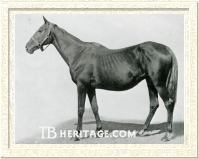
Orchidee
| |
Orchidee II, whom Prunus first serviced in 1923, was one of the best bred young mares in Germany, despite her "light and tucked up" physique and unattractive yellowish chestnut coloring. Her sire, Galtee More, was a winner of the English Triple Crown and was a half-brother to English Derby and Eclipse Stakes winner Ard Patrick. After initially standing successfully in Russia, Galtee More was purchased by the German government for stud duty, and both he and his half-brother, who also was recruited to stand in Germany, became quite successful in their new homeland. Orchidee II's dam was Orseis, a daughter of St. Serf and the Bend Or mare Orsova. Unraced, Orseis was sold as a broodmare prospect at the Newmarket December sales for only 40 guineas and sent to Germany. |
Orseis hailed from a noteworthy family, as her dam, Orsova, was a half-sister to Douranee, the second dam of Gondolette, a foundation mare for the Earl of Derby's stud. The family was classically active, Gondolette having produced One Thousand Guineas winner Ferry, and her full brother Sansovino, who emerged victorious in the Epsom Derby the same year Oleander was foaled. Orsova had also produced Austria, an Ayrshire daughter who became an important mare for the Schlenderhan Stud, her daughters and granddaughters producing several major performers, including Oesterreichisches Derby winner Csardas; Preis der Winterfavoriten winners Dolomit and Nubier; and Grosser Preis von Berlin winner Wallenstein.
Orchidee II lived up to her heritage and proved a splendid performer. At the age of three, she won nine of eleven starts, including the Preis der Diana and the Deutsches St. Leger. At stud, Orchidee II was dogged by ill fortune early on, and it wasn't until she was thirteen that she produced her first important offspring, the winning filly Odaliske. As a broodmare, Odaliske founded a nice family of her own, becoming the dam of two German classic winners in Orgelton and Octavianus and second dam of another in Ostermorgen. The year after Odaliske was foaled, Orchidee II produced a colt by Prunus. This was Oleander, a powerfully built solid bay colt.
Oleander on the Turf
From the time he first went into training, Oleander showed he was a colt of immense talent. He made two starts as a two-year-old, including the Sierstorpff-Rennen, winning both in a canter, before meeting with an accident which resulted in a fractured pelvis. For a time, the colt's life was despaired of. There seemed no possibility of him ever returning to the races, all his classic engagements were scrapped. The best veterinarians recommended he be put down. However, his trainer, Georg Arnull, felt the big bay colt was a once-in-a-lifetime horse, and doggedly nursed him day and night for months. It paid off, for Oleander not only returned to competition, but became a champion in each season he raced following his injury.
At three, Oleander captured his first two races before finishing third in the Grosser Preis von Hamburg. Started next for the Rheinisches-Rennen at one mile, Oleander won convincingly. He then embarked on a series of three victories, the Furstenburg-Rennen, the Grosser Preis von Baden, and the Galdiatoren-Rennen, which garnered him championship laurels as Germany's best three-year-old colt.
At four, Oleander began with a second place finish in the Chamant-Rennen. But then he embarked on a series of victories which left no doubt he was the best horse in Germany. The Jubilaums Preis in Berlin, the Grosser Preis von Berlin, the St. Simon-Rennen, the Grosser Preis von Osterreich, the Grosser Preis von Baden, and the Gladiatoren-Rennen all fell to the Oppenheim homebred.
Oleander's last start of the year took him outside Germany, to Longchamp near Paris, for the running of the Prix de l'Arc de Triomphe. The race had first been run in 1920, designed to bring the best horses three and up from France, Britain, and the rest of Europe together under weight-for-age conditions at the end of the season. In the first several runnings, France's great Bruleur had captured the race twice, and such good ones as Parth, Massine, and Priori, and Baribi had emerged victorious. In the 1928 edition, Oleander ran well, but finished fifth to Kantar. This was to be the only occasion in his racing career that Oleander would finish unplaced.
Oleander returned to the races as a five-year-old in 1929. He started out with a victory in the Chamant-Rennen, then blazed a swath through the Grosser Preis von Berlin, the St. Simon-Rennen, the Grosser Preis von Osterreich by ten lengths, and the Grosser Preis von Baden. His victory in the Grosser Preis von Baden was significant, for by winning it three straight years, he equaled the record of the champion Hungarian mare Kincsem, who won the event in 1877, 1878, and 1879. Oleander closed out his racing career with another appearance in the Prix de l'Arc de Triomphe.
The field for the Arc that season was outstanding. Besides Oleander and defending champion Kantar, the race boasted Italian classic winner Ortello, Poule d'Essai des Poulains winner Vatout, Prix de Diane heroine Ukrania, Prix Royal Oak winner Calandria, Charlemagne, winner of the Grand Prix de Deauville, Guy Fawkes, winner of the Prix d'Harcourt, and Palais Royal II, winner of the Cambridgeshire Handicap. Under rider Joe Childs, Oleander had a rough run in the race, and finished well to be third to Ortello and Kantar.
Oleander retired from the turf with 19 wins from 23 starts, with one second place and two third place finishes on his resume.
Oleander in the Stud
Oleander was sent to stud at the place of his birth, the Schlenderhan Stud, where he would prove an outstanding success with his very first crop. During his stud career, Oleander led the German sire list nine times, in 1935 and then every year 1937 through 1944.
The best member of his first crop, foals of 1931, was the filly SCHWARZLIESEL, out of Schwarz Kutte, by Black Jester. On the track, she was a victress in Germany's version of the One Thousand Guineas, the Schwarzgold-Rennen. She was no less impressive as a broodmare, as she became the dam of the brilliant filly Schwarzgold, who not only captured the Preis der Diana and the Zukunfts-Rennen, but took on and defeated colts by ten lengths in the Deutsches Derby and by a distance in the Grosser Preis von Berlin. Schwarzliesel became the matriarch of a family which over the generations would include such important winners as Scheherezade, Schonbrunn, Stuyvesant, Slenderella, and Epsom Derby winner Slip Anchor.
STURMVOGEL, a full brother to Schwarzliesel, was one of the members of Oleander's second crop, which included one other classic winner. Sturmvogel was almost as dominant as his sire had been on the racecourse. He was a winner of twenty-two races, including the Deutsches Derby, the Union-Rennen, Henckel-Rennen, two runnings of the Grosser Hansa Preis, the Jubilaums Preis, and two runnings of the Grosser Preis von Berlin. Sturmvogel's career at stud was short, as he was killed in an air raid during the second World War. He never sired anything approaching his own class, but as a broodmare sire, he claimed Gladiatoren-Rennen winner Andalusier and Alpsee, winner of the Grosser Preis von Hessen and the Spreti-Rennen.
The other classic winner from Oleander's second crop was the filly DORNROSE, produced from the Dark Ronald mare Dolly. She was inbred 3x2 to Dark Ronald. Dornrose was victorious in the Preis der Diana. She produced nothing of merit. CONTESSINA, out of Contessa Maddalena, by Landgraf, was the third major winner of Oleander's second crop, being a winner of the Oppenheim-Rennen and the Zukunfts-Rennen.
PERIANDER, foaled in 1933, was a son of Oleander out of the Fervor mare Persephone. Since Fervor was a son of Galtee More, Oleander's broodmare sire, this made Periander inbred 3x3 to that Irish-bred stallion. On the racecourse, Periander captured the Union-Rennen, and placed third to the outstanding filly Nereide in the Deutsches Derby. At stud, he was the broodmare sire of the Ticino filly Muskablute, victress in the Schwarzgold-Rennen. Another daughter of Periander, Glenaka, became dam of the stakes winning full brothers Giovanni (Preis der Winterfavotiten) and Granit (Ratibor-Rennen) and second dam of Preis der Diana victress Gerona.
TROLLIUS, like Periander, was out of a daughter of Fervor, the mare Tiberia. Foaled in 1934, Trollius recorded twelve victories, including the Grosser Preis von Baden, the Grosser Hansa Preis, the Zukunfts-Rennen, and ran second to Abendfrieden in the Deutsches Derby. At stud, Trollius sired the good filly Madelon, winner of the Prix de Malleret. Trollius was broodmare sire of the filly Ordinate and Master Bong, the former a winner of the Deutsches St. Leger, the latter a winner of the Washington D.C. International as well as stakes in France.
Oleander's 1935 crop included the colt MARSCHALL VORWARTS. Produced from the Wallenstein mare Mafalda, he was a half-brother to German classic winner Magnat. Marschall Vorwarts won the Deutsches St. Leger. He sired no recorded progeny.
In 1937, Oleander's next classic winner was foaled. This was the brown colt SAMURAI, out of Sonnenwende, by Nuage. Samurai was a victor in the Deutsches St. Leger and the Grosser Preis von Baden. He did not have a chance at stud in Germany, as he was one of many horses taken by the United States Remount Service, an act which caused considerable consternation among German breeders. Despite the fact that the German forces had randomly confiscated horses from the countries they had occupied, when the position was reversed and it was the Americans taking possession of Germany's horses, many German breeders questioned the legality of the act. Much bitterness ensued from the Americans confiscating horses which had been owned by private individuals. There was no argument about horses which had been confiscated from the German Army. The position of the United States was that ownership would be settled in the courts, but since that raised questions about which courts -- American or German -- had jurisdiction, most of the confiscated German Thoroughbreds remained United States property. Samurai wound up at stud in the United States, where he came up with a couple notable stakes winners, namely Wolf Gal, winner of the Hialeah Juvenile Stakes and Florida Breeders' Stakes, and Net Ball, winner of the Narragansett Special.
Oleander sired another Preis der Diana champion in his daughter SCILLA, foaled in 1938. Produced from the Wallenstein mare Schwarz-Weiss, Scilla had no recorded foals. Another top class member of Oleander's 1938 crop was the colt NUVOLARI, who was out of the brilliant German racefilly Nereide, by Laland. Nereide, undefeated victress of the Deutsches Derby and Preis der Diana, hailed from the same female family as the unbeaten Italian champion Nearco, both descending from the Spearmint mare Catnip. Nuvolari captured the Furstenburg-Rennen and the Grosser Hansa Preis. He placed third in the Deutsches Derby to Magnat. Nuvolari remained in Germany after the war, becoming a very successful sire, third on the German sire list in 1953 and second in 1955. Nuvolari's best runners was probably Stani, winner of the Grosser Preis von Baden, two runnings of the Grosser Preis von Hesen, the Grosser Preis von Frankfort, and the Grosser Preis von Dusseldorf and third in the Gran Premio del Jockey Club. Stani was also a fine sire, and was broodmare sire of Madruzzo, winner of the Deutsches St. Leger. Nuvolari was sire also of Imola and Salut, the former a winner of six races, the latter a winner of the Furstenburg-Rennen. Nuvolari was broodmare sire of German Horse of the Year and leading German sire Orsini.
ASTER, foaled in 1939, was a daughter of Oleander who was not only a fine race filly, but became an important matron, as well, founding a family which produced several German classic winners. Aster was out of the Wallenstein mare Arkebuse. On the track, Aster won seven races, her biggest win coming in the Deutscher Stutenpreis. At stud, she became the dam of Schlenderhan homebred Asterblute, considered one of Germany's greatest fillies, victress in the Schwarzgold-Rennen, Preis der Diana, and Deutsches Derby, and second in the Deutsches St, Leger. Asterblute was sired by Pharis, and she had a half-sister, named Aralia, who was sired by Alchimist. Aralia was a top filly too, capturing the Schwarzgold-Rennen. Over the years, German classic winners Ako, Arratos, Alaria, Anno, and major winners Anatas and Ataxerxes emerged, all tracing in tail-female to Oleander's daughter Aster.
Oleander was to prove his mettle as a sire outside Germany with two individuals from his 1940 crop, ORSENIGO and PINK FLOWER. The former was bred and raced in Italy by Giuseppe de Montel, master of Gornate Stud. Orsenigo was out of the Italian-bred mare Ostana, by Havresac II, a son of the St. Simon stallion Rabelais whom Montel had imported into Italy and who went on to lead the Italian sire list eleven times. During his racing career, Orsenigo won the Derby Italiano, the Gran Premio di Milano, the Premio Emmanuele Filiberto, and the Gran Premio d'Italia.
|
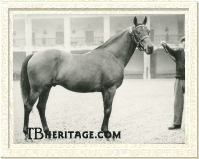
Orsenigo
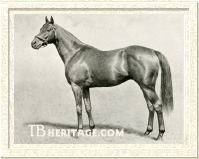
Pink Flower
| |
Orsenigo was leading sire in Italy in 1952 and 1954 and third in 1953. He was exported to South America, and stood in Brazil. His runners did well outside Brazil, for Orsenigo was second on Argentina's general sire list in 1960 and second on the Chilean list in 1958. His best runners included Tommaso Guidi (20 wins, including St. Leger Italiano); Staffa (Oaks d'Italia); Falerno (Premio Roma); and other winners Granet, Maenza, Meda, Sernaglio, and Chloe. Orsenigo's son Escorial, was a champion in Brazil, capturing that country's Triple Crown, as well as winning the Gran Premio Carlos Pelligrini in Argentina. Daughters of Orsenigo produced Italian classic winner Sedan, as well as Chitet, Mesnil, Sir Orden, Ormea, Serov, Chiadina, and Embuche. Orsenigo was sire of the second dams of Grosser Preis von Baden winner Salvo and Fortino, the latter sire of leading stallion Caro.
The story of Oleander's son PINK FLOWER is a touching one. His dam, the Polymelus mare Plymstock, was twenty-one-years-old in 1939 when her owner, Lord Astor, sent her to Germany to be covered by Oleander. She had been a fine broodmare in her youth, having produced Oaks heroine Pennycomequick when she was just eight, but nothing of any high class for over a decade. |
The result of her mating with Oleander was a small, weedy colt born in the spring of 1940 who was named Pink Flower. So small and unattractive was Pink Flower, Lord Astor literally gave him away to his stud groom, who in turn sent him on to Newmarket farmer W. Halford. This gentleman was so utterly convinced the colt would never amount to anything, he nearly sent the colt to be slaughtered, but had a change of heart and sent him to the Newmarket sales instead, hoping someone would be foolhardy enough to part with a little money to purchase him. A little amount did purchase him--only eighteen guineas, the buyer being Mr. J. Russell. He in turn sold the colt to Sir Alec Black.
The colt was trained and showed some promise. But he never raced in Sir Alec's colors, as the gentleman died. In the dispersal of his racing stock, Pink Flower was bought by trainer Harvey Leader for a friend, Captain Gillson. For his new owner, Pink Flower won three races at age two. At three, the colt no one had seemed to want, nearly captured the Two Thousand Guineas. He lost by only inches to Kingsway. Captain Gillson was killed in action early in 1944. He had willed the colt to Leader, who retired him to Newmarket's Brickfield Stud. Pink Flower did quite well as a sire, his best offspring being Wilwyn, winner of several races including the Limekiln Stakes and the inaugural Washington D.C. International. Wilwyn was sent to stand stud in South Africa, where he excelled. leading the South African sire list in 1964 and coming up with such stellar performers as South African Derby winner King Willow; champion Uncle Ben; South African Derby winner Lightning Path; as well as Kimberley Kid, Anchorage, Before the Mast, Perganum, and Willet. Wilwyn best representative as a broodmare sire was South African champion Cavon Creek.
Pink Flower's other good runners included Oleandrin, winner of the Craven Stakes and second in the Two Thousand Guineas; Flower Dust, a stakes winner in India; Sanguine, a winner of the Prix Morny; Pink Jasper and Desideria, both winners of the Fern Hill Stakes, and stakes winners Amaranthine and Denikin.
Perhaps Oleander's finest son was foaled in 1941. This was NORDLICHT, a full brother to NUVOLARI., both out of unbeaten Nereide. With such a family heritage, Nordlicht was invaluable just a stallion prospect. But this colt, who grew into a magnificent chestnut specimen, became a dual classic winner, taking the Deutsches Derby as well as its Austrian counterpart, the Oesterreiches Derby.
|
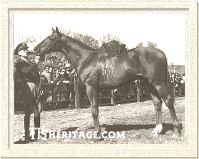
Nordlicht
| |
Like many other German horses, NORDLICHT was a spoil of war. His breeder, the Gestut Erlenhof, tried to hide some of their very best horses from the Allies, but the US forces had become wise to the trick of the Germans seemingly readily showing off horses to the occupying forces which were considered second string while hiding the prize animals in rickety outbuildings elsewhere on the farm property. Nordlicht was found in this manner, the story being that when an American soldier retrieved Nordlicht from a shed, the head stud groom repented, "Well you have the best now. That is Nordlicht, the finest horse in all Europe." |
Sent to the United States, NORDLICHT was eventually auctioned by the Remount Service at Front Royal, Virginia for $20,300. The successful bidders were a syndicate comprised of Christopher T. Chenery, Dr. L.H. Kraskin and William D. Pawley, master of Belvoir Farm near The Plains, Virginia. Unfortunately, Nordlicht failed to become a success, getting only a few minor stakes winners. After changing hands, he died at La Branche Plantation in St. Rose, Louisiana in 1968, aged 27.
Despite World War II raging in Europe, German breeding continued, and Oleander's output of important winning individuals kept going seemingly without interruption. His 1944 crop contained two high class performers. HONVED, was out of the French mare Horncastle, by Rialto. Honved was a good winner, capturing the Preis von Westfalen. At stud, he came up with several good stakes winners, including Aletsch, Granada, and Foliant, winner of the Derby del DDR.
The filly ISOLA BELLA, out of the Ferro mare Insbrunst, was the other top member of Oleander's 1944 crop. On the racetrack, she was a winner of the Osterreichisches Stutenpreis. She produced no recorded foals.
|
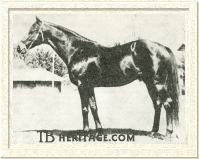
Espace Vital
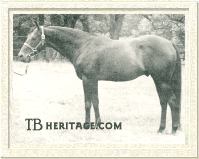
Asterios
| |
ESPACE VITAL, foaled in 1945, was produced from a French-bred daughter of Blenheim II. Espace Vital was sent to race in France in the years immediately after the war and acquitted himself admirably, capturing the Prix du Cadran, the Prix du Conseil de Municipal, Prix Jean Prat, and the Prix Kergorlay. Exported for stud duty to Chile, he became a leading sire there in 1968.
The last classic winner sired by Oleander, and his last top class son, was foaled in 1947. This was ASTERIOS, a homebred for Schlenderhan Stud. His dam was the Janitor mare Astarte, a member of the family which had produced Asterblute, dam of Oleander's aforementioned daughter Aster. Asterios was a winner of nine races, including the Deutsches St. Leger, the Gladiatoren-Rennen, and the Grosser Hansa Preis. Asterios was second in the Deutsches Derby. At stud, Asterios was often placed among the top ten on the German sire list, including third in 1963. His best representative was Waidmannsheil, winner of seven races, including the Jubilaums Preis and Basuto, winner of four races and placed in the Deutsches St. Leger. |
Oleander sired a total of eight German classic winners. He proved he was a truly top class stallion, capable of siring important winners at any age, as his first classic winner was foaled when he was seven, and his last at the age of 23. Oleander also proved an excellent sire of broodmares. Oleander's daughter ALEXANDRA produced Deutsches St. Leger champion Alejana. CONTESSA OLEANDA, a full sister to Oleander's stakes-winning daughter Contessina, became the dam of the filly Konigswiese, winner of the Schwarzgold-Rennen and Preis der Diana. In turn, Konigswiese produced a daughter by Ticino. Named Konigstreue, she was a victress in the Schwarzgold-Rennen.
NAJADE was a daughter of Oleander closely related to Nordlicht and Nuvolari., as she was a half-sister to their dam, Nereide. Najade was out of the Nella da Giubbio. Sent to the court of leading German stallion Ticino, Najade produced Deutsches Derby champion Niederlander. As a stallion, Niederlander stood in East Germany, where he got several good horses, including Derby del DDR winner Baba. Two winners of the Osterreichisches Derby were produced from Oleander mares: Pfalzerwald, produced from PFALZGRAFIN, and Takt, produced from TAKONIA. Oleander daughter ENTSCHEIDUNG became the dam of Engpass, a winner of the Derby Belge, or Belgian Derby.
Tactic, a winner of the Zukunfts-Rennen, was produced from the Oleander mare JOHANNISNACHT. The high class mare Silver City, a daughter of Ticino, was produced from Oleander's daughter SABINE. Silver City went on to capture the Schwarzgold-Rennen and the Deutsches Stutenpreis. Oleander's daughter OLYMPIADE became the dam of Olymp, winner of many races, including two runnings of the Grosser Preis von Munchen. AURIKEL became the dam of Furstenburg-Rennen winner Alraune, who in turn became the dam of the exceptional filly Aubergine, victress in the Deutsches St. Leger, Henckel-Rennen, and second in the Deutsches Derby. Finally, Oleander's daughter SORGE became second dam of two classic winners, Preis der Diana victress Sommerblume and Deutsches St. Leger winner Sudan.
Oleander died in 1947. His death had been erroneously reported in the Bloodstock Breeders Review a few years earlier, around the time his son Sturmvogel had been killed in an air raid. Oleander apparently survived the war, and died after a broken leg suffered in a paddock accident necessitated his destruction. He was 23-years-old.
--Liz Martiniak
|
|
|
|

